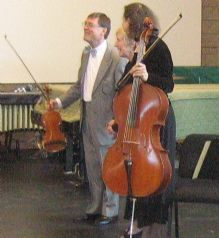|
Symphony
FROM THE NEW WORLD TO THE OLD WORLD
by Peter Lert
Saturday, June 14, 2025
Chamber
MC2 DUO RECITAL CLOSES 222'S SEASON
by Terry McNeill
Saturday, June 14, 2025
Choral and Vocal
CANTIAMO SONOMA'S LUSCIOUS A CAPELLA SINGING IN SEASON ENDING CONCERT
by Pamela Hicks Gailey
Sunday, June 8, 2025
Symphony
SRS SEASON ENDS WITH RESOUNDING TA-TA-TA-BANG
by Terry McNeill
Sunday, June 1, 2025
Symphony
YOUTHFUL VIRTUOSITY ON DISPLAY AT USO'S MAY CONCERTS
by Peter Lert
Saturday, May 17, 2025
Symphony
MYSTICAL PLANETS AND LIVELY GERSHWIN ORTIZ AT FINAL SRS CONCERT
by Peter Lert
Sunday, May 4, 2025
Symphony
VSO'S CONCERT MUSIC OF TIME, MUSIC OF PLACE
by Peter Lert
Sunday, April 27, 2025
VOCAL ELEGANCE AND FIRE AT THE 222'S RECITAL APRIL 26
by Pamela Hicks Gailey
Saturday, April 26, 2025
CANTIAMO SONOMA SINGS AN INSPIRED GOOD FRIDAY MOZART REQUIEM CONCERT
by Pamela Hicks Gailey
Friday, April 18, 2025
DRAMATIC SHOSTAKOVICH SYMPHONY CLOSES PHILHARMONIC'S 25TH SEASON
by Terry McNeill
Sunday, April 13, 2025
|
 |
 Trio Navarro at SSU Easter Sunday Concert |
ROREM'S KNOTTY SPRING MUSIC PLAYED BY TRIO NAVARRO AT SSU CONCERT
by Terry McNeill
Sunday, April 24, 2011
Continuing a stellar history of innovative piano trio programming, the resident SSU Trio Navarro closed their season April 24 in an Easter Sunday concert replete with two large novelties and a slightly more familiar work by Beethoven.
Before 90 listeners in the Green Music Center’s orchestra rehearsal room, the Navarro first tackled Rorem’s Spring Music, an eclectic 1990 work premiered by the Beaux Arts Trio. In five extended movements, the music isn’t easy to easily assimilate and in his introductory remarks violinist Roy Malan alluded to the composer’s clever compositional nature and the sobriquet of music’s “bad boy.” Both references have validity, though in at least the last century George Antheil could lay claim to both epithets. But Rorem is very much alive, each of his many books a salacious experience and his large oeuvre provocative, especially in the non-vocal pieces.
The Spring Music I found haunting, the three instrumental lines often far apart and then often in unison, and an insistent rhythmic pulse everywhere in evidence save for a lyrical Fantasia section. In this section cellist Jill Rachuy Brindel has long solos in a low register and in duos with Roy Malan’s violin line. Low frequencies in the cello were rich. Pianist Marilyn Thompson never overpowered her colleagues and the part oddly was frequently removed from the instrumental texture with loud bass chord crashes and propulsive right-hand skips for the piano and high tessitura for the violin.
This is a work of sharp contrasts and often contradictory character, and also it’s a piece of glorious instrumental sound that the composer manipulates deftly and the afternoon’s highlight for this reviewer. Was it well played? I suspect so, at least on a single hearing amid the less-than-reverberant acoustics of the room.
The first half ended with a late 19th Century novelty, Carl Frühling’s A Minor Trio, Op. 40. It’s Brahmsian from the first measure and through four movements never retreats from an initial bucolic outlook. There are continual harmonic references to Franck’s Quintet, written 20 years earlier, and to the music of Louis Vierne and St. Saens’ lush tone poem “Omphales’s Spinning Wheel.” At times thick and insurgent harmonies blurred the lyrical nature of the work and it was at turns repetitious. The Navarro played it with gusto and a sprinkle of wrong notes in the piano. The big Brahms-like phrases in the coda of the finale Allegro vivace brought this strange work to a powerful conclusion.
If Rorem could be described as clever and Frühling imitative, neither could be said of Beethoven and his E-Flat Major Trio, Op. 70, No. 2, the sole second half work. The Bonn master is endlessly inventive in this cheerful trio, a close partner in style and sound to the Op. 69 cello sonata. There was cohesive playing in the opening Poco sostenuto as well as the following two Allegretto movements. The Narvarro’s strengths were readily apparent, rhythmic security and etched vocal lines, but also some sloppy ensemble playing and persistent intonation problems from Mr. Malan. In the Allegro finale there was stylish playing, the movement’s joy readily communicated. No encore was offered.
Finishing another exemplary season the Trio Navarro continued its long string of exploration of provocative works with the Rorem’s bracing music overshadowing the lyrical Frühling and the systematic Beethoven reading. An energetic balance indeed for a warm spring day concert.
|

